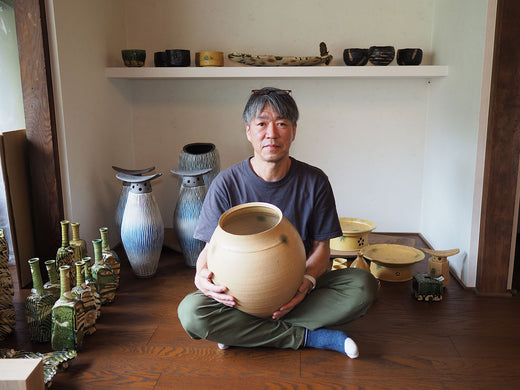
Interview with Mr. Mitsuhide Kato of Daiun Kiln
Fascinated by Kiseto and Setoguro, the challenge of pottery and the future of Mino ware
Profile/Ceramics history
(Kato Mitsuhide)
Born in Toki City, Gifu Prefecture in 1968. Graduated from the Ceramics Department of Kyoto College of Art in 1989. He went on to study at the Kyoto Prefectural Pottery Technical College, graduating in 1991. He returned to Toki City in 1995 and continued making pottery while working in the manufacturing industry as a potter. He was also responsible for exhibitions as vice-president of the Mino Ceramic Art Association, a public interest incorporated association, and was recognized for his contributions to the development of Mino ceramic art.
(Award history as of 2025)
In 1996, he received the Chunichi Encouragement Award at the Mino Ceramic Art Exhibition, in 2001 he received the Tokyo Governor's Award at the Japan New Crafts Exhibition, and in 2005 he was selected as a Mino Ceramic Art Permanent Preservation Artifact. In 2012 he received the Silver Award at the Shouroku Award Tea Bowl Exhibition, in 2015 he received the 1st Mino Ceramic Development Tomoko Award, and in 2024 he received the 42nd Takuo Award.
Located a short distance from the center of Toki City, Gifu Prefecture, Oroshi Town is lined with buildings of pottery factories and ceramic shops. Turning slightly off the main road, we walk up a hill and find Daigun Kiln just before the top of a small hill. We visited the studio and spoke to them. In the room just before the studio, there's a striking table, made from a door that was originally going to be discarded when the old main house was renovated. The many mugs lined up in the room suggest that the studio is also active in the pottery industry. Also on display are succulent plants handmade by San'ei's wife, adding a touch of color to the tranquil space. San'ei took the time to share his valuable insights with us despite his busy schedule ahead of his solo exhibition.
Pottery making in Kyoto and encounter with Kiseto
Sanei's ceramics career began in Kyoto. He studied ceramics at an art university and training school, and while working in the ceramics industry, he actively participated in exhibitions. He met his wife while they were both ceramic artists and lived in Kyoto for around eight years. When it was pointed out to him that none of his work featured techniques from his hometown of Mino, he began working with kiseto ware, going from mainly ash glazes to also using kiseto ware.
He showed us a Kiseto vase that he plans to exhibit. Its pale yellow body is decorated in places with blue-green tanpan (aluminum). When minerals are powdered and embedded in the base material, they turn green and act as an accent, but Sanei says, "Synthetic chemical sulfate has no impurities, so the green color is just too beautiful ." "I happened to get my hands on some natural minerals this time," he says, picking up a bag containing small, sparkling blue chunks of mineral.
"The traditional plump finish of Kiseto ware was enhanced with a bluish-black, dark green color, and the result was exactly what I wanted," says Sanei, but he adds that in recent years, it has become more difficult to achieve the characteristic yellow color of Kiseto ware by simply mixing ash and feldspar. The yellow color is apparently due to the subtle iron content of the glaze, but the iron content in modern ash has been decreasing.

Challenging unique techniques and a commitment to Setoguro
Sanei is concerned that the supply of high-quality raw materials that produce the traditional colors is decreasing year by year. Although it is possible to produce the yellow color of Kiseto with just one type of ash, Sanei deliberately mixes three types of ash, including earth ash and oak ash, and adds a few percent of iron to create his handmade glaze. "So that I won't be in trouble if I can't get hold of these materials someday," he says, and is taking precautions now just in case.
He also takes great care in selecting the oak ash he uses, traveling all the way to Wakayama Prefecture to purchase two tons of red pine firewood and turning it into ash. While hard, oily coniferous wood is said to make good firewood, red pine firewood has become increasingly difficult to obtain in recent years. Burning two tons of firewood in a fireplace produces six kilograms of ash, and once the lye is removed, the amount drops to just two kilograms. Even so, the lye is so strong that it can dry out your hands if you touch it directly, and he carefully uses this ash for his Kiseto pottery.
The same dedication is shown in his work with Setoguro. When he was studying under Kato Kozo, he apparently developed a strong attachment to Setoguro while helping out during the firing of the kiln. Believing that "it's not interesting to make the same thing over and over again," he adapted a technique called "carbonized black" to produce the black color by sealing the pottery in rice husks, rather than the traditional method of rapidly cooling high-temperature pottery with water (hikideguro). He also uses silver glazes to create pieces that are full of originality.
While Sanei is always striving for originality and creating better works, he feels he still has a long way to go. While Setoguro was originally only used to make tea bowls, Kozo's works, regardless of size, stand out for their stunning colors, especially when photographed. When considering the difference, Sanei says, "The answer lies in the firewood." By firing using firewood in a climbing kiln or anagama kiln while controlling the temperature and humidity, ash naturally flies off and adheres to parts or the entire bowl, creating a "kiragi" (scraping) effect. Apparently, this produces a completely different finish than works fired in a gas kiln. For this reason, Sanei dreams of one day building a wood-fired kiln and using it to create pottery.

Admiration for Shino and the future of traditional techniques
Furthermore, he says he would like to try his hand at "Shino" ware, which he has not yet worked on, but laments the fact that he is unable to obtain feldspar, the raw material for the glaze. Although he has a kiln in Mino and can still obtain the clay and soil essential for Mino ware, there is a serious shortage of natural minerals and firewood, and Sanei feels a great sense of crisis, as this threatens the survival of traditional Mino ware, which is fired in a wood-fired kiln.

In addition to resource shortages, there seems to be a common concern regarding the preservation of traditional techniques. "If all ceramic artists simply buy the glazes they've been given and fire their work in electric or gas kilns, traditional techniques will likely disappear," he said. Looking back on his time as a young artist, Mihide says that by joining craft associations and pottery associations, he had the opportunity to learn everything from his predecessors through intergenerational relationships. This allowed him to internalize traditional techniques, techniques, and experiences. Mihide's career as an artist seems to have been "blessed with people." The lessons he learned from these vertical connections, which cannot be gained solely through the horizontal connections available via modern social media, are applied to his pottery. It seems that, as he approaches 60, he now sees "nurturing the next generation" as his mission.

He also told me a very interesting story when I asked him about ash. Apparently, in the old days in Kyoto, there was a recycling system in which charcoal and ash used in cooking in hearths were collected by businesses, which dye shops used to remove the lye when dyeing, and then collected again and given to pottery shops. Amazingly, a system similar to what we now call the SDGs already existed.
The traditional techniques and methods of Mino pottery that Sanei learned from his elders and predecessors will be passed on to the present day through Sanei, and then passed on to young artists. I imagined a future for Mino ware where this cycle of techniques continues.
(August 2024, Interview: Chika Shimura)
information
Ogumo kiln
2549-1 Shimoishicho, Toki City, Gifu Prefecture, 509-5202




